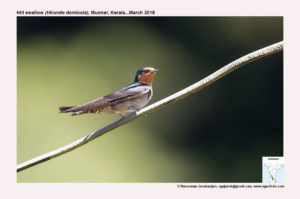Hill Swallow

Hill Swallow Hirundo tahitica domicola
Etymology:
- Hirundo : Latin word for Swallow
- Tahitica : From Tahiti
- Domicola : Latin word domi –house; cola –dweller
Distribution in India: Widespread winter visitor except North, North West and parts of EastIndia.
Description: Size of 13 cm; wt. of 11–16 g. The nominate race has arufous-chestnut forehead, crown and upperparts are glossy steel-blue; wings and tail are brownish-black, tail is slightly forked, pale margins on inner webs of rectrices; throat rufous-chestnut, rest of underparts are brownish-black, undertail-coverts are grey-brown with dark subterminal band and pale tips. Both the sexes are alike. The juvenile is duller, rufous areas paler and has short tail.
Habitat : It is found in sea coasts, open country, forested hills, and human habitations, especially near water. It is found from sea-level to 2400 m.
Food habits: It eats insects like hymenoptera, flies, beetles and termites. It forages alone or in groups, its flight is fast, with frequent turns and short glides. It feeds over grassland, cultivation, forest rivers and roads.
Breeding habits: They breeds in Mar–May in India, Feb–May in Sri Lanka; Mar–May in Myanmar, Jan–Aug in Malay Peninsula; Jan–May in Ryukyu Is, Mar–May, Jul and Oct in Philippines, Dec–Jul in Borneo; and Nov and Dec in Tahiti. The nest is built by both sexes, a half-cup made of mud pellets, lined with dry grass, rootlets, lichens and feathers; close to overhang, often over water, on cliff, in cave, on tree stump, culvert, bridge, jetty or verandah, under eaves, or on rafter inside building. The nest is repaired and reused in successive years. They lay a clutchof 2–3 egg. The incubationis done by female alone. The incubation period is 15–17 days. The chicks are fed by both sexes with feeding rates highest in late morning and at dusk. The fledging period is 17–22 days. The young return to nest at night for several days.